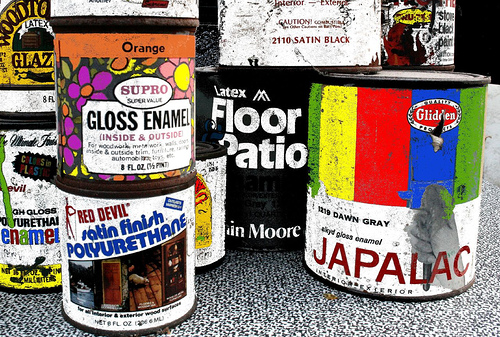Water-Based Paint vs Oil-Based Paint
How do I Choose the Right Paint?
It seems so straightforward... you decide that a wall, a baseboard or a piece of furniture needs painting so you need to buy paint, right? Pick it up at the hardware store, nothing could be simpler – until you are faced with the choice of what paint to buy. Should it be acrylic, emulsion, satin, gloss, semi-gloss, alkoyd, eggshell, matt? Does it need a primer? Is it safe to use near children? – Argh! What is even more confusing is that different kinds of paint can do the same job but with vastly different results. So... how do you choose?
It helps to know the properties of paint before you make a costly mistake – not just because good paint is expensive, but the object you are painting could be damaged or left unprotected.
Broadly speaking, paint for household use is divided into two kinds: water-based or solvent/oil-based. There are other kinds of paint but these are the most common and most widely used.

Water-Based Paint
Also called latex, acrylic or emulsion. In fact, there is no natural latex in any kind of paint – it is made from synthetic polymers. In other words, when you apply a coat of paint to a wall, you are giving it a layer of plastic. Water-based paint was once only suitable for interior walls. It was not hard-wearing enough for woodwork or floors. However, new developments in paint means that water-based paint now has many more applications in the home, and accounts for about 80% of domestic paint sales. It is easy to apply and can be cleaned up with water. There is a huge selection of colors and sheens available from flat/chalk (matte/ultra-matte) to a shiny satin finish. Water-based paint is generally low-odor and safe for children's rooms but always check the label to make sure.

Where to Use Water-Based Paint
Water-based paint can be used on walls, ceilings, wood, door frames, window frames, baseboards, furniture and on exterior walls. Always check the manufacturer's recommendations for individual paints. Generally when applying to a previously unpainted surface, you will need to prime with a suitable undercoat. If painting over a previous coat of water-based paint, you can usually dispense with primer, unless you are changing the color dramatically, say from dark to light.
Oil or Solvent-Based Paint
Also known as alkyd (or 'gloss' in the UK), oil-based was once the only choice of paint. If you wanted a water-based paint, you had to use whitewash (a solution of water, slaked lime and chalk) or milk paint. Alkyd paint is generally more hard-wearing than latex. It is less prone to flaking but colors can fade under intense sunlight and over time. Before it dries it has a strong distinctive odor. It also takes longer to dry, although that can be an advantage because brush marks will tend to flatten out. Oil-based paint has to be cleaned up with solvents.

Where to use Oil-Based Paint
Oil-based paint is best suited to wood surfaces, such as doors, frames, baseboards, floors and furniture. It can be applied to walls but it's not recommended. On a personal note, when we were looking for our second home, my first husband and I viewed a dear little stone-built cottage. A cowboy builder had bought it cheap with the intention of making a quick profit and had painted all the exposed stonework interior walls with a deep purple gloss paint. Everywhere. Needless to say, we declined to make an offer.
Again, you will have to apply a primer to a previously unpainted surface and if repainting over an oil-based finish, you will need to sand the surface to provide a key for the new paint. You may be wondering why you would want to choose an oil-based paint if there are suitable water-based ones. If the surface requires a very hard-wearing finish, then oil-based is your best choice. It is also best for creating special paint effects, such as marbling though there are now water-based paints that can do that job too.
Safety Precautions When Painting
Always refer to the manufacturer's instructions before commencing painting. Ventilate the room. Wear a safety mask when using oil-based paint and never use near a naked flame. Dispose of old paint, including paint scrapings, carefully as it may contain lead.
If you have old oil-based paint cans and left over paint to get rid of, take it to your nearest municipal/city waste collection depot. They should have facilities there to deal with it. The same goes for a large amount of scraped off paint.
How to Tell the Difference Between Oil-Based and Water-Based Paint
Read the paint can label – if it instructs you to clean paintbrushes with warm water and soap, then it's water-based. If it tells you to use mineral spirit or turpentine, then the paint is solvent/oil-based.
What about painted surfaces? There are several ways to determine what kind of paint was used. If you can press your fingernail into the paint and it leaves an impression then the paint is likely oil-based. If you have a heat gun, direct it at an out-of-sight area of the surface. If the paint bubbles and smells of solvents, it is oil-based. Rub a little nail varnish remover on an unobtrusive area – if paint comes off then it is water-based. You can just rub hard with a damp white rag - if you can see the paint color on the rag, the paint is water-based.
© 2012 Bev G



